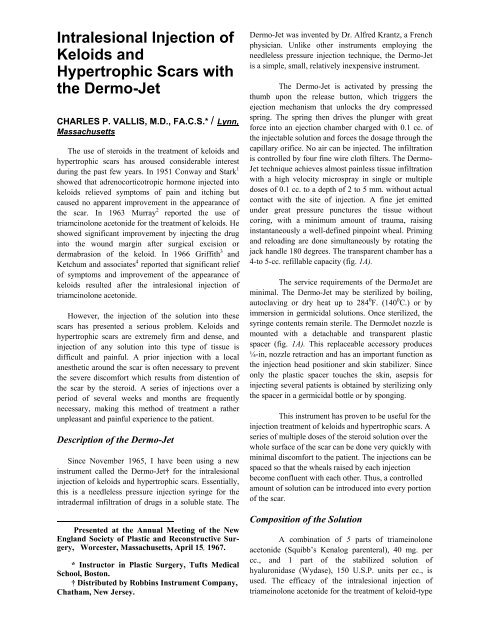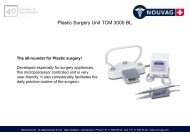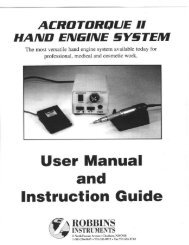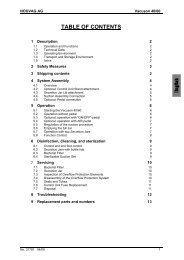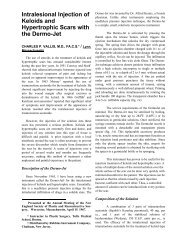Intralesional Injection Of Keloids And Hypertrophic Scars - Robbins ...
Intralesional Injection Of Keloids And Hypertrophic Scars - Robbins ...
Intralesional Injection Of Keloids And Hypertrophic Scars - Robbins ...
You also want an ePaper? Increase the reach of your titles
YUMPU automatically turns print PDFs into web optimized ePapers that Google loves.
<strong>Intralesional</strong> <strong>Injection</strong> of<br />
<strong>Keloids</strong> and<br />
<strong>Hypertrophic</strong> <strong>Scars</strong> with<br />
the Dermo-Jet<br />
CHARLES P. VALLIS, M.D., FA.C.S.* / Lynn,<br />
Massachusetts<br />
The use of steroids in the treatment of keloids and<br />
hypertrophic scars has aroused considerable interest<br />
during the past few years. In 1951 Conway and Stark 1<br />
showed that adrenocorticotropic hormone injected into<br />
keloids relieved symptoms of pain and itching but<br />
caused no apparent improvement in the appearance of<br />
the scar. In 1963 Murray 2 reported the use of<br />
triamcinolone acetonide for the treatment of keloids. He<br />
showed significant improvement by injecting the drug<br />
into the wound margin after surgical excision or<br />
dermabrasion of the keloid. In 1966 Griffith 3 and<br />
Ketchum and associates 4 reported that significant relief<br />
of symptoms and improvement of the appearance of<br />
keloids resulted after the intralesional injection of<br />
triamcinolone acetonide.<br />
However, the injection of the solution into these<br />
scars has presented a serious problem. <strong>Keloids</strong> and<br />
hypertrophic scars are extremely firm and dense, and<br />
injection of any solution into this type of tissue is<br />
difficult and painful. A prior injection with a local<br />
anesthetic around the scar is often necessary to prevent<br />
the severe discomfort which results from distention of<br />
the scar by the steroid. A series of injections over a<br />
period of several weeks and months are frequently<br />
necessary, making this method of treatment a rather<br />
unpleasant and painful experience to the patient.<br />
Description of the Dermo-Jet<br />
Since November 1965, I have been using a new<br />
instrument called the Dermo-Jet† for the intralesional<br />
injection of keloids and hypertrophic scars. Essentially,<br />
this is a needleless pressure injection syringe for the<br />
intradermal infiltration of drugs in a soluble state. The<br />
Presented at the Annual Meeting of the New<br />
England Society of Plastic and Reconstructive Surgery,<br />
Worcester, Massachusetts, April 15, 1967.<br />
* Instructor in Plastic Surgery, Tufts Medical<br />
School, Boston.<br />
† Distributed by <strong>Robbins</strong> Instrument Company,<br />
Chatham, New Jersey.<br />
Dermo-Jet was invented by Dr. Alfred Krantz, a French<br />
physician. Unlike other instruments employing the<br />
needleless pressure injection technique, the Dermo-Jet<br />
is a simple, small, relatively inexpensive instrument.<br />
The Dermo-Jet is activated by pressing the<br />
thumb upon the release button, which triggers the<br />
ejection mechanism that unlocks the dry compressed<br />
spring. The spring then drives the plunger with great<br />
force into an ejection chamber charged with 0.1 cc. of<br />
the injectable solution and forces the dosage through the<br />
capillary orifice. No air can be injected. The infiltration<br />
is controlled by four fine wire cloth filters. The Dermo-<br />
Jet technique achieves almost painless tissue infiltration<br />
with a high velocity microspray in single or multiple<br />
doses of 0.1 cc. to a depth of 2 to 5 mm. without actual<br />
contact with the site of injection. A fine jet emitted<br />
under great pressure punctures the tissue without<br />
coring, with a minimum amount of trauma, raising<br />
instantaneously a well-defined pinpoint wheal. Priming<br />
and reloading are done simultaneously by rotating the<br />
jack handle 180 degrees. The transparent chamber has a<br />
4-to 5-cc. refillable capacity (fig. 1A).<br />
The service requirements of the DermoJet are<br />
minimal. The Dermo-Jet may be sterilized by boiling,<br />
autoclaving or dry heat up to 284 0 F. (140 0 C.) or by<br />
immersion in germicidal solutions. Once sterilized, the<br />
syringe contents remain sterile. The DermoJet nozzle is<br />
mounted with a detachable and transparent plastic<br />
spacer (fig. 1A). This replaceable accessory produces<br />
¼-in, nozzle retraction and has an important function as<br />
the injection head positioner and skin stabilizer. Since<br />
only the plastic spacer touches the skin, asepsis for<br />
injecting several patients is obtained by sterilizing only<br />
the spacer in a germicidal bottle or by sponging.<br />
This instrument has proven to be useful for the<br />
injection treatment of keloids and hypertrophic scars. A<br />
series of multiple doses of the steroid solution over the<br />
whole surface of the scar can be done very quickly with<br />
minimal discomfort to the patient. The injections can be<br />
spaced so that the wheals raised by each injection<br />
become confluent with each other. Thus, a controlled<br />
amount of solution can be introduced into every portion<br />
of the scar.<br />
Composition of the Solution<br />
A combination of 5 parts of triameinolone<br />
acetonide (Squibb’s Kenalog parenteral), 40 mg. per<br />
cc., and 1 part of the stabilized solution of<br />
hyaluronidase (Wydase), 150 U.S.P. units per cc., is<br />
used. The efficacy of the intralesional injection of<br />
triameinolone acetonide for the treatment of keloid-type
scars is well documented. I have added the Wydase to<br />
the steroid solution because it appears to cause greater<br />
diffusion of the solution. I also believe that it lessens<br />
the stinging pain which often results after injection of<br />
the steroid. Cornbleet 5 stated that infiltration of the scar<br />
with Hyaluronidase produces softening even of old,<br />
hard keloids and some diminishing in size.<br />
Method of Treatment<br />
The technique is simple and is performed as an<br />
office procedure. Several patients are usually done<br />
simultaneously to prevent wastage of the solution. Only<br />
the plastic cuff on the end of the instrument needs<br />
sterilization between patients. No type of anesthesia is<br />
required. The scar to be injected is sponged off with a<br />
mild antiseptic solution. With each injection by the<br />
Dermo-Jet, a pale white wheal measuring<br />
approximately 1 to 1.5 cm. in diameter is attained. The<br />
injections are spaced so that the wheals from each<br />
injection more or less touch each other and fuse. The<br />
entire scar is injected at one sitting. In the smaller scars<br />
only 1 or 2 injections may be needed. As many as 25 to<br />
30 injections have been done for some of the larger<br />
scars. The instrument is placed vertically over the scar<br />
so that the removable and easily sterilized plastic cuff<br />
on the end touches the scar (fig. 2). Rarely, when there<br />
is a small area to inject, the plastic cuff may obscure the<br />
lesion. Then it is wise to remove it and keep the nozzle<br />
of the instrument approximately ½ cm. above the scar.<br />
After the first treatment is completed, the<br />
patient is advised to return again in 2 weeks, at which<br />
time a second injection is done if necessary. After the<br />
second injection series, the patient is advised to come<br />
back in a month. Many patients do not require more<br />
than 2 series of injections. However, the larger keloids<br />
may require several doses. One had a total of 10 series<br />
of injections spaced about 1 month apart.<br />
For the initial injection it is best to acquaint the<br />
patients with the machine and allow them to hear the<br />
“snap” of the machine before giving the injection.<br />
Many of the younger patients are frightened by the appearance<br />
of the machine and the snapping sound. This<br />
sometimes makes them hypersensitive to the small<br />
amount of pain caused by the injection. By and large,<br />
these patients are much more cooperative for<br />
subsequent injections.<br />
Table I<br />
Location No. of Patients<br />
Left shoulder 6<br />
Arms 6<br />
Anterior chest wall 4<br />
Face 3<br />
Abdomen 3<br />
Thigh 1<br />
Foot 1<br />
Hand 1<br />
Mastoid 1<br />
Neck 1<br />
Back 1<br />
Total 28<br />
Clinical Material<br />
Since November 1965, 28 Caucasian patients<br />
with keloid or hypertrophic scars have received a<br />
combined total of 64 injection series of this mixture of<br />
triamcinolone acetonide and Wydase.<br />
The ages of 22 patients ranged between 6 and<br />
29 years, and the other 6 patients were between 33 and<br />
70 years of age. The average age was 22 years. Seven<br />
were men and 21 were women.<br />
<strong>Of</strong> the 22 patients in the younger age group, 14<br />
had scars which were considered to be true keloids. All<br />
the scars treated in the older age group were<br />
hypertrophic scars. The locations of the scars are shown<br />
in table 1.<br />
The causes of the scars varied. <strong>Of</strong> the 14<br />
keloids, 6 were the result of vaccinations, 3 resulted<br />
after surgical excision of benign lesions, I from a burn,<br />
2 from infection due to acne and 2 from injury. <strong>Of</strong> the<br />
14 hypertrophic scars, 8 resulted from operative incisions,<br />
3 from injuries, 2 from burns and 1 from<br />
dermabrasion on the face. At the time of the initial<br />
treatment of these patients, the lesions had been present<br />
from 2 months to 10 years with an average of 3 years.<br />
A total of 64 series of injections ranging from<br />
1 to 10 were given to the 28 patients. Nine are still<br />
under treatment. A total of 49 series were given to the<br />
completed 19 cases, making an average of 2.6. <strong>Of</strong> the<br />
28 patients treated, 14 had no symptoms referable to the<br />
scars, and they were primarily interested in improving<br />
the appearance of the scars. In the remaining 14, the<br />
most common symptoms were chronic itching and pain.<br />
<strong>Of</strong> these 14, 10 were interested in relief of symptoms<br />
and improvement of the appearance of the scars. The<br />
remaining 4 were interested only in relief of symptoms
Clinical Results<br />
Relief of symptoms.<br />
An analysis of the 4 patients seeking only<br />
relief of symptoms proved interesting.<br />
1. A 38-year-old woman had had a hysterectomy<br />
through a lower vertical mid-abdominal<br />
incision 2 years previously. She developed a<br />
raised, hypertrophic, reddish brown scar<br />
measuring 2 in. by 9 in. The scar was<br />
extremely sensitive and painful. She was<br />
unable to wear a girdle or other tight clothing<br />
over the scarred area. The entire scar was<br />
injected with the Dermo-Jet initially, and the<br />
patient had complete relief of symptoms within<br />
48 hr. after the injection. The patient<br />
subsequently had 2 additional series of<br />
injections with complete flattening of the scar<br />
and permanent cessation of the symptoms.<br />
2. A 70-year-old man had had a colon resection<br />
through a lower vertical mid-abdominal<br />
incision 10 months previously. He developed a<br />
raised, painful, hypertrophic, reddish brown<br />
scar measuring % in. by9 in. This patient also<br />
had complete relief of symptoms after the<br />
initial injection. He subsequently had 2<br />
additional series of injections with complete<br />
flattening of the scar.<br />
3. A 42-year-old woman had a similar raised<br />
hypertrophic scar on the right flank resulting<br />
from a nephrectomy operation 18 months<br />
previously. This patient was very apprehensive<br />
and had been under psychiatric care for a<br />
depressed state. This scar measured 3/8 in. by<br />
8 in. Her symptoms were relieved after 2 series<br />
of injections. A major portion of her scar was<br />
flattened. This patient was one of a few who<br />
complained of severe pain during the injection<br />
and also persistent burning pain for several<br />
hours after the injection.<br />
4. A 19-year-old girl complained of severe pain<br />
to pressure over a small localized area of<br />
subcutaneous scarring on the sole of the left<br />
foot following removal of a plantar wart 2<br />
years previously. This patient had 1 injection<br />
with the Dermo-Jet. The scar softened and<br />
completely disappeared with cessation of<br />
symptoms within a month after treatment.<br />
<strong>Of</strong> the other 10 with symptoms, 9 had<br />
complete relief of symptoms within 48 hr. after the<br />
initial series of injections. The remaining patient was a<br />
33-year-old woman with multiple hypertrophic scars on<br />
the palm of the left hand resulting from a crush injury 5<br />
months previously. She had 5 series of injections with<br />
softening and leveling of the scars and marked<br />
improvement of symptoms. She still complained of<br />
moderate pain to pressure over a tight scar on the<br />
proximal crease of the palm.<br />
Appearance of the scar<br />
Analysis of the appearance of the scars after<br />
injection indicated a very favorable response to the<br />
therapy. Nine patients are still under treatment. <strong>Of</strong> the<br />
remaining 19 patients, 14 had complete leveling of the<br />
keloid or hypertrophic scars. <strong>Of</strong> the 14, 4 were small<br />
keloids averaging 1,4 in. in diameter resulting from<br />
vaccination. The other 10 were hypertrophic scars<br />
resulting from surgery or injury. <strong>Of</strong> the 5 of the 19 who<br />
showed incomplete leveling of the scar, 2 had 80 to 90<br />
per cent leveling.<br />
1. The patient was a 17-year-old girl with a large<br />
recurrent keloid on the left shoulder measuring<br />
2½ in. in diameter. It was of 3 years’ duration<br />
and resulted from the surgical excision and<br />
graft of another keloid resulting from<br />
vaccination. X-ray therapy was also given at<br />
the time of the surgical excision. She had a<br />
total of 8 series of injections over a period of<br />
10 months.<br />
2. An 18-year-old boy had a keloid over the left<br />
mastoid area resulting from a car accident. The<br />
scar measured 3/8 in. by 1 in. He had a total of<br />
3 series. Three showed a 60 to 75 per cent<br />
leveling of the scar.<br />
3. A 21-year-old man had multiple keloids on his<br />
chest resulting from acne. He<br />
had a total of 7 series of injections.<br />
4. A 42-year-old woman had a hypertrophic scar<br />
on the right flank following a nephrectomy.<br />
She had a total of 2 series of injections.<br />
5. A 14-year-old boy had a large keloid on the<br />
left side of the neck resulting from injury. He<br />
had had a surgical excision with Z-plasty<br />
repair 1 year previously with marked<br />
recurrence of the keloid which measured 1 1/2<br />
in. by 5 in. He had a total of 10 series of injections<br />
over a period of 12 months with about<br />
75 per cent flattening of the scar.
Pain experienced during and after injection.<br />
The Dermo-Jet has proven itself to be a very<br />
useful instrument in the injection treatment of keloid<br />
and hypertrophic scars primarily because of the ease of<br />
administration. of the drug. No form of anesthesia is<br />
necessary with the Dermo-Jet.<br />
A controlled amount of solution is given with<br />
each injection, and there is visible evidence in the form<br />
of pale white wheals to indicate whether the entire scar<br />
has been injected. An analysis of the amount of pain<br />
resulting from the injections with the Dermo-Jet proved<br />
interesting. I have used this instrument on myself and<br />
some of my fellow workers. The pain noted during the<br />
injection into normal skin on the arm was minimal and<br />
insignificant. It felt like a tiny transient “pinch” in the<br />
skin. There was no after pain.<br />
<strong>Of</strong> the 27 patients treated, 18 complained of<br />
minimal or insignificant pain during the injection. Most<br />
stated that it felt like a tiny mosquito bite, and they<br />
were able to tolerate several injections during each<br />
series without any complaint. Six complained of<br />
moderate pain with the initial series of injections. They<br />
described it as a momentary sting. They were also able<br />
to tolerate multiple injections, and most of them had<br />
minimal pain with subsequent injections. Three<br />
complained of severe pain during the injection.<br />
1. A 21-year-old girl had a large keloid burn scar<br />
of the right cheek of 7 months’ duration. This<br />
patient had had a total of 6 previous Kenalog<br />
injections with a needle and syringe and also<br />
radiation therapy elsewhere. She was<br />
extremely agitated, and treatment had to be<br />
suspended after only a few injections with the<br />
Dermo-Jet. When this patient returned for her<br />
second treatment 1 month later, 1 part of 2 per<br />
cent Xylocaine was added to the 6 parts of<br />
Kenalog and Wydase. She was assured that the<br />
pain would be negligible, and she was able to<br />
tolerate about 15 injections with only minimal<br />
to moderate complaints of pain.<br />
2. A 42-year-old maiden lady had a painful<br />
hypertrophic scar on the right flank 18 months<br />
after a nephrectomy. She had been under<br />
psychiatric treatment for a chronic depressed<br />
state. This patient stated that the injection<br />
caused a sharp painful stinging sensation.<br />
However, she did tolerate 5 injections with the<br />
first series and then came back a month later<br />
for a second series at which time she had 10<br />
injections. This patient also complained of<br />
persistent stinging pain in the scar for several<br />
hours post injection.<br />
3. A 10-year-old boy had a large recurrent<br />
hypertrophic scar on his left arm measuring 1<br />
in. by 6 in. This boy had had 2 previous<br />
operative procedures for gradual partial<br />
excision of a much larger scar. He complained<br />
of severe pain during the multiple injections.<br />
He returned 1 month later for a second series<br />
of injections. Again, 1 part 2 per cent<br />
Xylocaine solution was added to 6 parts of<br />
Kenalog and Wydase, and this time he<br />
tolerated the treatment with minimal complaints<br />
of pain.<br />
Rees 6 has tried the Dermo-Jet for injecting<br />
Kenalog solution into hypertrophic scars, and he has<br />
noted that his patients have complained of very severe<br />
sensations of pain and burning in the scar for several<br />
hours following treatment. In fact, he has found it more<br />
painful than direct injection by needle. My experience<br />
has shown that the great majority of patients complain<br />
of minimal pain. I believe that the addition of the<br />
Wydase markedly lessens any post injection pain. The<br />
addition of a small amount of local anesthetic to the<br />
Kenalog solution would also diminish any post injection<br />
pain in patients who complain initially. Reassurance of<br />
these patients and their acquaintance with this<br />
instrument before treatment help considerably in minimizing<br />
any discomfort.<br />
Discussion and Summary<br />
This paper has been principally written to<br />
acquaint the medical profession with a useful new<br />
instrument, the Dermo-Jet. The DermoJet has been<br />
employed for the intralesional steroid injection of<br />
keloids and hypertrophic scars in a total of 28 patients.<br />
A definite improvement evidenced by disappearance of<br />
the symptoms and leveling or flattening of the scars was<br />
noted in all cases. Some scars showed a faster and more<br />
spectacular response than others. The most dramatic response<br />
was noted in the hypertrophic scars resulting<br />
from surgery or injury. Complete flattening of these<br />
scars resulted after only 1 to 4 series of injections.<br />
The true keloids, especially the larger ones, showed a<br />
slower response. Softening and flattening proceeded<br />
slowly, and a large number of doses were needed over a<br />
longer period of time. The small keloids resulting<br />
from vaccination showed a quick, dramatic response to<br />
only 1 or 2 series of doses.<br />
In the hypertrophic operative scars of the<br />
abdomen, the principal complaint was burning pain and
itching. In these patients, contact of their clothing over<br />
the scar caused discomfort. It was gratifying that their<br />
symptoms were quickly relieved after just a few<br />
injections.<br />
Most patients experience minimal pain when<br />
the solution is injected into the scar. They tolerate the<br />
procedure well without the need for any type of<br />
anesthetic. Most of the patients have some<br />
apprehension with the first series of injections.<br />
However, subsequent injections are taken with minimal<br />
discomfort. The few who complained acutely during the<br />
initial injection tolerated subsequent ones quite well.<br />
This method of treatment is not being<br />
proposed for all scars that come to a surgeon’s<br />
attention. In many patients, surgical excision, when<br />
indicated, is still the quickest and most efficient form of<br />
treatment. <strong>Intralesional</strong> injection of steroids into a<br />
raised scar will level the scar and smooth it out but it<br />
will not narrow it. This technique does not replace the<br />
tried and proven techniques of the plastic surgeon. It<br />
should be used as an aid to surgery to be done when the<br />
surgeon begins to notice even the slightest recurrence of<br />
hypertrophy or keloid formation after surgery. In<br />
known keloid formers who are undergoing surgery, the<br />
technique of Griffith’ of injecting Kenalog with a<br />
regular syringe into the wound at the time of the<br />
surgery appears to have merit. <strong>Intralesional</strong> injection<br />
could also be used for most true keloids when the<br />
surgeon feels that surgery would be of no avail. This<br />
method may be used in cases that have already had a<br />
surgical attempt at correction. It has proven to be<br />
especially effective in patients who are more concerned<br />
with the symptoms caused by the scar than with the<br />
appearance.<br />
Other Uses of the Dermo-Jet for the Plastic<br />
Surgeon<br />
There are a number of situations in medicine<br />
where the Dermo-Jet has already proven itself quite<br />
useful, e.g., in mass vaccinations. I have found it very<br />
useful in removing plantar warts under local anesthesia.<br />
The Dermo-Jet is used for the subtopical injection of a<br />
local anesthetic. Greater depth can be achieved by<br />
inserting a needle with additional anesthetic solution<br />
painlessly into the wheal center. I have also been<br />
exploring the possibility of the intralesional injection of<br />
the plantar wart itself with a solution that would result<br />
in resolution of the wart.<br />
Another possible use of the Dermo-Jet which I<br />
have also been considering is the injection of a<br />
sclerosing solution into some of the smaller raised<br />
hemangiomas. Its use in the larger hemangiomas would<br />
be limited since the scierosing solution would not penetrate<br />
more than 5 to 6 mm.<br />
Conclusion<br />
The Dermo-Jet, a needleless pressure injection<br />
instrument, has proven to be of great value for the<br />
intralesional injection of keloids and hypertrophic scars.<br />
The technique is simple and quick with minimal<br />
discomfort to the patient.<br />
41 Ocean Street<br />
Lynn, Massachusetts 01902<br />
REFERENCES<br />
1. Conway, H., and Stark, R. B.: ACTH in plastic<br />
surgery. Plast. & Reconstruct. Surg., 8: 354— 377,<br />
1951.<br />
2. Murray, R. D.: Kenalog and the treatment of<br />
hypertrophied scars and keloids in Negroes<br />
and whites. Plast. & Reconstruct. Surg., 31:<br />
275—280, 1963.<br />
3. Griffith, B. H.: The treatment of keloids with<br />
triamcinolone acetonide. Plast. & Reconstruct.<br />
Surg., 38: 202—208, 1966.<br />
4. Ketchum, L. D., Smith, J., Robinson, D. W., and<br />
Masters, F. W.: The treatment of hypertrophic<br />
scar, keloid and scar contracture by triamcinolone<br />
acetonide. Plast. & Reconstruct. Surg., 38: 209—<br />
2 18, 1966.<br />
5. Cornbleet, T.: Treatment of keloids with hyaluronidase.<br />
J. A. M. A., 154: 1161—1163, 1954.<br />
6. Rees, T. D.: Personal communication.


